Christianity - 2
In the 19th century philosophical and historical criticism did inspire some Christians to renew the search for essences.
For example, in the wake of the German Idealist philosopher G.W.F. Hegel, Hegelian scholars tried to rescue Christianity by
viewing it as an unfolding of "absolute spirit." They followed Christian history through a constant dialectic, a series of
forces and counterforces producing new syntheses.
A problem with this Hegelian approach arose as the historical Jesus came to be seen merely as one stage in the unfolding
of absolute spirit; he was not a decisive agent of the way of salvation "once for all," as the biblical Letter to the Hebrews
had claimed him to be. Soon biblical scholars such as David Friedrich Strauss were speaking of the historical Jesus as a myth
of a certain set of people in one moment of the dialectical unfolding. The Christian faith itself began to dissolve, and many
Hegelians began to reject the God of the Christian faith along with the historical Jesus.
Another group of 19th-century theologians took the opposite course. In the spirit of the 18th-century German philosopher
Immanuel Kant, these neo-Kantians spoke not of the noumenal world, the unseen realm of essences beyond visible reality, but
of the phenomenal realm, the world of history in which things happened. Theologians in this school engaged in a century-long
"quest for the historical Jesus," in which they sought the simple essence of Christianity. Significantly, it was the greatest
exemplar of this historical tradition, the German theologian Adolf von Harnack, who wrote the best-known modern book on the
essence of Christianity, Das Wesen des Christentums (1900; What Is Christianity?).
The call had come to purge Christianity of what Harnack called traces of "acute Hellenization," the Greek ideas of essence,
substance, and being that were introduced into the Christian tradition in the creed-making period. Instead, the focus was
shifted to the Fatherhood of God and the announcement of the Kingdom, as the rabbi Jesus of Nazareth had proclaimed in the
Gospels.
While this approach did match the thirst for simplification in the minds of many of the Christian faithful, it also so
diminished the concept of God that it often became a form of Christian humanism and was seen by the orthodox to be another
departure from the essence of Christianity even as it claimed to find this in the historical Jesus. And scholars could not
agree on the details of that historical Jesus after historical and literary critics had analyzed the Gospels.
Throughout the modern period some thinkers took another route toward expressing the essence of Christianity. Whether among
German Pietists, the followers of John Wesley into Methodism, or any number of Roman Catholic or Protestant movements of devotion,
there grew the notion that the theologians would never find the essence of Christianity.
Instead, one would discern this essence in acts of piety, closeness to the fatherly heart of God as shown in the life of
Jesus, or intimate communion with God on emotional or affective, and not cognitive, rational, or substantial (i.e., doctrinal),
grounds. These pietisms have been immensely satisfying to millions of modern believers, though they have often been handicapped
in the intellectual arena when pressed for the definitions people need in a world of choice.
There have been some modern Christians who have shifted the topic from the essence of Christianity to its absoluteness
among the religions. They have been moved by what the Germans called Religionswissenschaft, the study of world religions.
In that school, the focus fell on the sacred, what the German theologian Rudolf Otto called "the idea of the Holy."
There could be any number of expressions of this idea. On those terms, as the German scholar Ernst Troeltsch showed, it
was more difficult to speak of the "absoluteness" of Christianity and its truth; one had to speak of it on comparative terms.
Yet some early 20th-century comparativists, such as the Swedish Lutheran archbishop Nathan Söderblom, applied their understanding
of the study of religion to help animate the movement for Christian reunion.
The modern ecumenical movement is made up of people who believe the church has different cultural expressions that must
be honoured and differing confessional or doctrinal traditions designed to express the essential faith. These traditions demand
criticism, comparison, and perhaps revision, with some possible blending toward greater consensus in the future.
At the same time, years of serious ecumenical endeavour have shown that, among Christians of great intelligence and good
will, elaborations of what constitutes the essence of Christianity are as confusing as they are inevitable and necessary.
In the Protestant and Orthodox side of the ecumenical movement, which took institutional form in the World Council of Churches
in 1948, there were two main strands. Both of these included advocates of what were types of essential concepts. One set was
devoted first to "Life and Work," a view that the essentials of Christianity could be best found and expressed when people
followed the way or did the works of Christ, since this constituted his essence.
The other set, concerned with "Faith and Order," stressed the need for comparative study of doctrine, with critical devotion
to the search for what was central. By no means did these groups cling any longer to the notion that when they found unity
they would have found a simple essence of Christianity.
Yet they believed that they could find compatible elements that would help to sustain them on the never-ending search for
what was central to the faith tradition.
Some modern scholars--for example, the British theologian John Hick--viewing the chaos of languages dealing with the essentials
of the faith and the complex of historical arguments, pose the understanding of the essence in the future. They speak of "eschatological
verification," referring to the end, the time beyond history, or the time of fulfillment. In that future, one might say, it
will have become possible to assess the claims of faith. Theologians of these schools argue that such futuristic notions motivate
Christians and the scholars among them to clarify their language, refine their historical understandings, and, some would
say, focus their devotion and spirituality.
The question of Christian identity
From these comments on the search for the essence of Christianity, the task of defining the core of the faith tradition,
it can be seen that at all times the question of Christian identity is at stake. What the psychologist Erik Erikson said of
the individual, that a sense of identity meant "the accrued confidence that one's ability to maintain inner sameness and continuity
. . . is matched by the sameness and continuity of one's meaning for others," is thus translated to the concerns of the group.
This means that Christians strive, in the midst of change, to have some "inner sameness and continuity" through the focus
on Jesus Christ and the way of salvation.
At the same time, Christians posit that this identity will be discoverable by and useful to those who are not part of the
tradition: secularists, Buddhists, Communists, or other people who parallel or rival Christian claims about truth and salvation.
On these terms, the writers of Christian history normally begin phenomenologically when discussing Christian identity;
that is, they do not bring norms or standards by which they have determined the truth of this or that branch of Christianity
or even of the faith tradition as a whole but begin by identifying everyone as Christian who call themselves Christian.
Thus, from one point of view, the Church of Jesus Christ of Latter-day Saints, or the Mormons, is, as scholar Jan Shipps
calls it, "a new religious tradition." The followers of the Book of Mormon incorporated the Old and New Testaments into their
canon--just as the New Testament Christians incorporated the entire scripture of a previous tradition--and then supplied reinterpretations.
As a new religious tradition, Mormonism would not be Christian. But because Mormons use Christian terminology and call
themselves Christian, they might also, from some points of view and in some areas, belong to a discussion of Christianity.
They may be perceived as departing from the essence of Christianity because other Christians regard their progressive doctrine
of God as heretical. Yet Mormons in turn point to perfectionist views of humanity and progressive views of God among more
conventionally accepted Christian groups.
In areas where the Mormons want to be seen as "latter-day" restorers, basing their essential faith on scriptures not previously
accessible to Christians, they would be ruled out of conventional Christian discussion and treatment. Yet they share much
of Christian culture, focus their faith in Jesus, proclaim a way of salvation, and want to be included for other purposes,
and thus fall into the context of a Christian identity at such times.
This phenomenological approach, one that accents historical and contemporary description and resists prescription, does
not allow the historian to state the essence of Christianity as a simple guide for all discussion. It is necessary for the
scholar to put his own truth claims in a kind of suspension and to record faithfully, sorting out large schools of coherence
and pointing to major strains.
It is not difficult to state that something was a majority view if the supporting data are present. For example, it is
not difficult to say what Roman Catholics at particular times have regarded as the essence of Christianity or what the various
Orthodox and Protestant confessions regard as the true way of salvation. Someone using the phenomenological method, however,
would stand back and refuse to be the arbiter when these confessional traditions disagree over truth.
Vincent of Lerins, then, speaks more for the hunger of the Christian heart or the dream of Christian union than for the
researcher, who finds it more difficult to see a moment when everyone agreed on everything everywhere. Yet provisionally it
remains safe to say that Christian identity begins and ends with a reference to Jesus in relation to God's truth and a way
of salvation. The rest is a corollary of this central claim, an infinite set of variations and elaborations that are of great
importance to the separated Christians who hold to them in various times and places.
- Encyclopedia Britannica
Israeli cave linked to John the Baptist ABC - August 2004
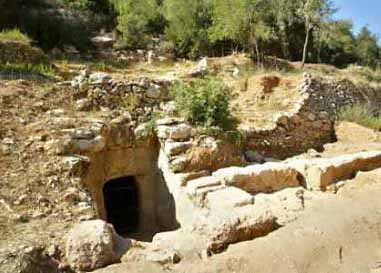
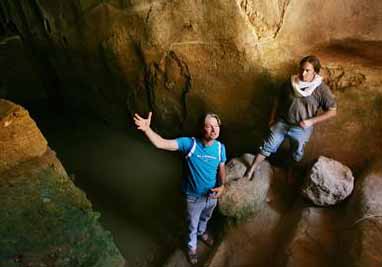
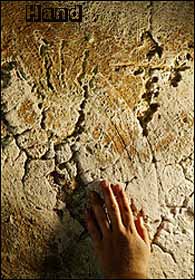
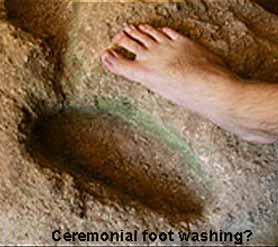
What did Jesus look like? Discovery - August 2004
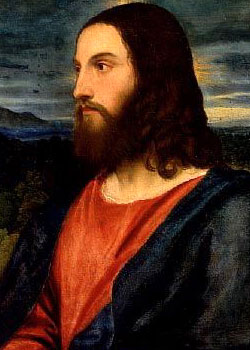
16th-century Italian Renaissance - Titan
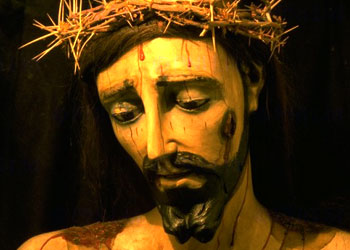
18th-century wooden statue - Mexico
What was the 'Star of Bethelem'?
By Anthony Aveni - Professor of Anthropology and Astronomy - Colgate University
1. It may simply have been a bright star, a supernova (an old star which, in a gravitational death spasm, blazes forth
for a few months before gasping its last breath of nuclear energy)
2. Or, a recurrent supernova (the same, except that several hundred years generally intervene between spasms).
3. Some believe it was a constellation, more portentous than a single star.
4. A bright comet...Halley's has been mentioned.
5. Others say the great luminary was really two comets, a meteor shower, or a fireball (a colossal meteor visible only
in a small part of the world).
6. A few have nominated the aurora borealis (northern lights).
7. There are those who contend the star should have been called the Planet of Bethlehem--Venus hovering over the horizon
or transiting the surface of the sun.
8. Combinations of sky phenomena have been suggested, including a conjunction of two or more planets, such as the triple
conjunction (three close visual passes in a row) of Saturn and Jupiter in the constellation of Pisces in 7 B.C.
9. A planetary conjunction plus a comet.
10. Or eclipses of Saturn and Jupiter by the moon.
11. The zodiacal light, a reflection of sunlight off interplanetary particles in the plane of the planets' orbits, has
been cited. 12. UFOs.
A second category of explanation avoids the necessity of scientific accountability by positing a theophany, an aura of
light surrounding God, a supernatural radiance. A third category raises the possibility that the star is neither chronological
nor literal and that identifying it either naturally or supernaturally serves no purpose, that it is "just a story."
Which of these explanations one opts for depends on who is asking the question--astronomer, theologian, or historian--and
what constitutes meaning for each in the historical framework in which he or she makes the inquiry.
Dialogue With The Firmament
An oft-missing element in comprehending the story of the Star of Bethlehem is the vital role that astrology played in ancient
beliefs about the natural world. Even today, a 1997 poll found that 37% of Americans believe in astrology--up from 17% in
1976. The doctrine linking celestial events to earthly activities--"as above, so below"-- influenced all levels of society,
from nobility to peasantry, and all forms of activity, from politics and science to medicine and agriculture. Rome at the
time of nascent Christianity was no exception.
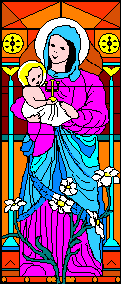
Jesus was raised as a carpenter. His early years are undocumented but many feel he spent some years in Egypt and was possibly
educated by the Essenes. He was a follower of John the Baptist.
The teachings of Jesus are unusual for the period of time and appealed to all segments of Roman society.
Jesus fulfilled the Old Testament Messanic prophecy. All humans are created equal. One should serve his fellow man. Only
God could--and should--avenge wrongs. Humans should respect earthly law. Violence of any kind is wrong.
Jesus was martyred. He angered the Pharisees by his teachings. Charges of heresy were brought against Jesus by the Pharisees
during Passover Week. The Roman Procurator, Pontius Pilate, was pressured by the Pharisees to execute Jesus after the Jewish
court (Sanhedrin) refused to try him. Jesus was crucified by the Romans (C. 30 AD).
He was labeled the "Christos" (Anointed One) after his followers claimed he was resurrected.
The immediate followers of Jesus (Apostles) are also martyred for their beliefs.
1. Andrew; crucified on an X-shaped cross in Greece.
2. Bartholomew; Skinned alive.
3. Simon Peter; Crucified upside
down in Rome.
4. James the Just; throat was cut by Herod Agrippa.
5. John; Beheaded at Ephesus.
6. Mathew; Crucified
in Greece.
7. Thomas; Martyred in India.
8. James the Lesser (Brother of Jesus); stoned to death.
9. Judas Iscariot;
committed suicide.
Paul, a converted Jew, is the man most responsible for spreading the Christian faith throughout the
Roman empire. Almost 1/3 of the books of the New Testament is attributed to him. Born Saul of Tarsus, he had a conversion
on the road to Damascus. His special mission became the conversion of the non-Jew (Gentile) to Christianity.
Religious ceremonies develop slowly into the now accepted Sacraments of the Church.

Baptism; Symbolized the washing away of sin and rebirth and was popularized early by John the Baptist.
Holy Eucharist; Symbolized the last communion with Jesus and his followers. This practice became very controversial because
of the concept of "Transubstantiation".
Confirmation; A ritual celebrating adulthood.
Penance; A confession of sin.
Ordination; The passing on of power, this sacrament established the authority of church leadership.
Matrimony; Considered a religious rite. Celibacy of priests came much later.
Extreme Unction; The last rites before death.
Early Church organization copied the leadership pattern of the Roman Empire.
Deacon- led each local congregration.
Bishop- oversaw several Deacons
Archbishops-developed to see large Bishoprics.
Eventually the Bishop of Rome became the unofficial leader of the church and gained the title of "Pope".
The first Bishop of Rome was Simon Peter, the apostle.
Early persecutions of Christians, although sporadic, were cruel.
The Roman government and citizenry was generally tolerant of early Christianity since they posed no threat to their government.
The most vocal opponents of the early church came from the Jewish religion.
Only when Christians refused to participate in Emperor Worship did they begin to be persecuted in large numbers.. Nero
was the first emperor to persecute the Christian followers on a large scale.
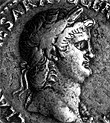
Persecution reached its height during the reign of Diocletian who attempted to systematically eliminate the followers.
Christianity finally became legal during the reign of Constantine with the Edict of Milan in 312 AD.
Early heresies concerning the nature of Jesus threaten the new beliefs of the Christian church.
Docetists; Followers of Marcion believed that the human body of Jesus was a phantom.
Nestorianism; Followers of Nestor believed that God dwelt in the body of Jesus like a temple. Jesus was merely a vessel.
Monophysites; They believed that the nature of Jesus was wholly divine.
Arianism; This belief proved the greatest challenge to the early church. Led by Arius (256-336), the Bishop of Hippo in
North Africa, he taught that Jesus was similar to an angel, not human, but not quite God-like. His thoughts had many followers
including the emperor Constantine.
Gnosticism; Followers believed that the Holy Spirit was superior to either Jesus or God. Their belief in mysticism eventually
led to the monastic movement. The Gnostic influence can be seen in the New Testament, particularly the Gospel of John.
Church Councils are held to settle many of the questions of early Christianity.
The Council of Niacea was called in 325 by Constantine to settle the question of the nature of Jesus. The council was attended
mostly by eastern bishops. The result was the "Nicene Creed" or the "Apostles Creed" which defined the nature of Jesus in
terms of the Trinity. Arianism, although weakened, persisted into the Middle Ages. The Council of Carthage in 397 is held
to formulate the "Canon" of the church.
Many books attributed to the apostles were present during this era. The council voted on which ones to accept into the
"Bible".

Those left out became known as the "Apocraphra" or Hidden Books.
This included
Apocalyptic books by Peter and James;
Allegorical books such as the "Shepherd of Hermas";
Several Books of Acts such as that of Andrew.
Revelation was accepted by one vote. The Canon was comprised mainly of the four Gospels and letters (Epistles) of the apostles.
The literature of the Essenes were completely ignored.
Several church leaders help form the doctrine and theology of the early Christian church.
Ignatius (85-107); A bishop of Antioch, he first coined the term "Catholic".
Justin Martyr (C 3rd century); A legendary figure whose "Apology" to
Antoninus Pious in defense of Christianity had a great impact on future writings.
Irenaeus (115-200); Bishop of Lyon, he opposed Gnosticism and was the main promulgator of the cult of the "Virgin Mary".
Tertullian (160-220); Bishop of Carthage, he wrote extensively on the morals of the early church. He was eventually excommunicated.
Origen (185-254); He wrote over 6000 books in an attempt to harmonize Christian though with Greek philosophy. He was also
later excommunicated.
Ambrose (340-397); Bishop of Milan, he established the concept of the church leaders having power over secular rulers.
Jerome (340-420); Expert linguist, he translated the Hebrew writings into Latin. His version of the Bible, the "Vulgate",
became the official version up to the Renaissance.
Augustine (354-430); The greatest of the Latin Fathers, he was a Bishop of Hippo whose writings included the "City of
God" and his "Confessions". He is considered the primary theologian of the early church and had great influence on the concepts
of original sin, salvation by grace and the sacraments.
Symbols of the early church develop over many centuries
Symbols were used because Christians often hid from the persecutions of the emperors. Early Christians were also hesitant
to artistically portray Jesus. First artistic representation of Jesus depicts him as a young man with short hair, void of
beard and wearing the rough garment of a Roman peasant. Traditional depictation did not arise until the Middle Ages.
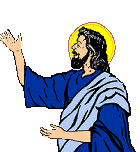
The earliest Christian symbols were the "fish" and the "peacock".
and the "peacock".
The cross was widely used as a Christian symbol from the 5th century.

Music was not widely used until its standardization by Pope Gregory I (590-604) in the form of "Gregorian Chants".
Monasticism and Asceticism develop as important movements in the early Christian church.
Monasticism; A desire to bring about the union of one's soul with God.
Asceticism; The complete renunciation of all worldly temptations. These concepts had been in existence as evidenced by
John the Baptist and the Essene movement. Jesus taught salvation through renunciation.
Stoicism also taught a peace through detachment from worldly things. Monasteries became centers for the preservation of
classical learning and the transferral of that knowledge to modern times.
Early monastics included;
Anthony of Egypt (251-356); Considered the "Father of Monasticism". He lived in a cave for many years;
St. Simeon (C-4th century); A legendary figure, he reportedly lived atop a pole in Damascus for 30 years;
Benedict of Nursia (480-543); The head of Monte Casino, he is considered the most important figure in the Monastic movement.
He established the rules for monasteries which were followed thoughout the Middle Ages.
- Encyclopedia Britannica

History of the Roman Catholic Church Wikipedia
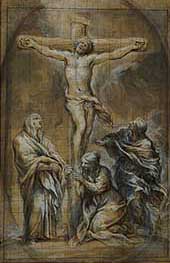
History of the True Cross Wikipedia
News Articles
Archaeologists identify traces of miracle pool MSNBC - December 2004
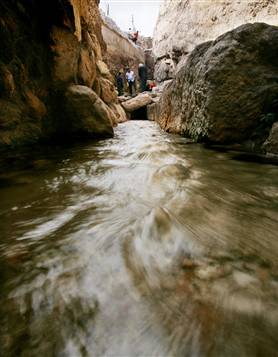 Siloam Pool was where Jesus was said to cure blind
Siloam Pool was where Jesus was said to cure blind

